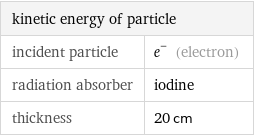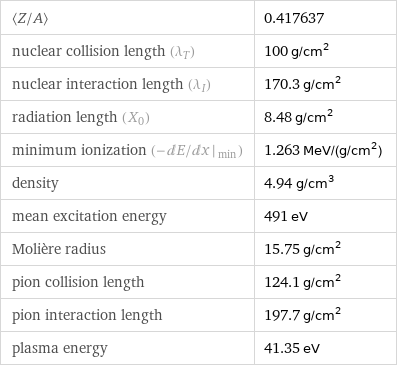Input interpretation

kinetic energy of particle | incident particle | e^- (electron) radiation absorber | iodine thickness | 20 cm
Result

107 GeV (gigaelectronvolts)
Comparison as energy for 107 GeV

≈ 0.86 × mass-energy of a Higgs boson particle ( 1 m_H^0 c^2 )

≈ 1.1 × mass-energy equivalent of a Z boson ( ≈ 1.5×10^-8 J )

≈ 1.3 × mass-energy equivalent of a W boson ( ≈ 1.3×10^-8 J )
Comparison as kinetic energy for 107 GeV

≈ ( 0.11 ≈ 1/9 ) × approximate kinetic energy of a flying mosquito ( ≈ 1.6×10^-7 J )
Absorber material properties

〈Z/A〉 | 0.417637 nuclear collision length (λ_T) | 100 g/cm^2 nuclear interaction length (λ_I) | 170.3 g/cm^2 radiation length (X_0) | 8.48 g/cm^2 minimum ionization (- dE/ dx |_ min) | 1.263 MeV/(g/cm^2) density | 4.94 g/cm^3 mean excitation energy | 491 eV Molière radius | 15.75 g/cm^2 pion collision length | 124.1 g/cm^2 pion interaction length | 197.7 g/cm^2 plasma energy | 41.35 eV